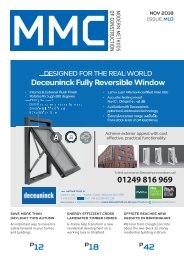a.aa MMC M11 52pp Web
You also want an ePaper? Increase the reach of your titles
YUMPU automatically turns print PDFs into web optimized ePapers that Google loves.
article<br />
OFFSITE MANUFACTURING VITAL TO THE<br />
SUCCESS OF LONDON BRIDGE<br />
As offsite manufacturing continues to provide innovative and valuable solutions to major infrastructure projects, Nick Brautigam Project<br />
Director at building envelope specialist Prater discusses its benefits in relation to the successful delivery of the London Bridge<br />
redevelopment.<br />
With the after effects of Mark Farmer’s<br />
2016 government review still rippling<br />
through the industry today, a number of<br />
main contractors are now making offsite<br />
fabrication a requirement on all large-scale<br />
projects – a trend that will undoubtedly become<br />
an ever-increasing focus in the future. This<br />
methodology is by no means new, however with<br />
construction output on the increase and clients<br />
looking to appoint project partners that can truly<br />
add value to the process – it comes as no great<br />
surprise that the use of offsite manufacturing is<br />
increasing.<br />
Here at Prater, we are now incorporating elements<br />
of offsite manufacturing across a number of our<br />
projects and are continuing to proactively invest in<br />
our inhouse factory facilities to further develop our<br />
offsite solutions. A fantastic example of our use of<br />
this methodology is our development of London<br />
Bridge Station. The station, which serves 125,000<br />
commuters a day, underwent a major<br />
redevelopment programme, a six-year-long<br />
upgrade that now offers an increased number of<br />
routes and destinations with a better travel<br />
experience for passengers.<br />
London Bridge faced a common challenge posed<br />
to developments in large, congested cities; lack of<br />
space onsite. On top of this, the station is the<br />
fourth busiest in the UK, meaning that speed of<br />
work onsite was essential, creating as minimal<br />
impact to the stations day to day running as<br />
possible. Offsite manufacturing played a crucial<br />
role in our extensive scope of works on the<br />
development, where the complex structure of the<br />
canopies, tight timescales and restricted access<br />
meant that an onsite solution was not practical.<br />
After early engagement with our dedicated supply<br />
chain partners and detailed discussions with<br />
Network Rail, Costain and the architect Grimshaw,<br />
a decision was made to invest in building a fullscale<br />
constructability prototype of a 60m-long<br />
platform section in North Yorkshire. This was then<br />
dismantled and rebuilt, with the idea to challenge<br />
the buildability of the project in line with site<br />
restrictions and constraints, enhancing the end<br />
quality of the build and the confidence of all<br />
parties in the final result. This innovative<br />
methodology provided insight, not only into the<br />
aesthetic of the finished build but also the<br />
performance of the end solution – whilst still<br />
being able to check the accuracy of the build<br />
against the 3D model.<br />
To assist collaborative working, Prater established<br />
an offsite manufacturing facility to house all its<br />
supply chain partners for the project. Severfield<br />
was responsible for steelwork and Prater worked<br />
on the roof cassettes, whilst the M&E contractor<br />
was responsible for installing the interfaces,<br />
incorporating: lighting; PA equipment; PIR sensors<br />
and security cameras. To ease the build process,<br />
the cassettes were built into adjustable transport<br />
frames – allowing the team to access the<br />
underneath sections of the structure.<br />
Even with work being undertaken 24/7 by a<br />
number of teams onsite, the sheer scale of the<br />
project demanded the redevelopment be<br />
completed over five years. However, by<br />
manufacturing much of the roof canopies offsite,<br />
one lift with a power crane could lift up multiple<br />
elements at a time, speeding up the overall<br />
installation and the amount of time the machinery<br />
was needed onsite. In addition, skilled workers<br />
who created the prototype offsite were utilised<br />
during the installation process of the cassettes –<br />
removing the learning curve and ensuring the<br />
installation was consistent. This guaranteed the<br />
highest quality of delivery and also further saved<br />
time on installation.<br />
The prefabrication of the building components in<br />
an industrialised factory environment also ensured<br />
an increased level of consistency, and the<br />
reduction of any defects. For larger, more complex<br />
infrastructure projects such as London Bridge,<br />
where bespoke designs are required, the ability to<br />
construct a test version is crucial to accessing<br />
strengths, weakness and potential issues with the<br />
project.<br />
Perhaps the most significant benefit that arose<br />
from offsite manufacturing was that it allowed us<br />
to reduce risk, by taking work away from the site<br />
and in a controlled environment. As 90% of the<br />
cassette manufacture and build was taken offsite<br />
and only 10% comprising the installation and<br />
fitting of infill panels onsite, most of the work was<br />
undertaken at ground level – significantly<br />
reducing risk across the entire project by reducing<br />
unnecessary work at height. In fact, we can<br />
proudly say that over all the 650 thousand manhours<br />
spent on the project there was not a single<br />
serious incident.<br />
Modernisation and progression are key to the<br />
future of the construction industry, and offsite<br />
manufacturing is an ideal technique for achieving<br />
this. We have seen a dramatic increase in the<br />
number of clients opting to utilise our offsite<br />
manufacturing capabilities, and the type of work<br />
being undertaken is setting new benchmarks for<br />
the construction industry – particularly when it<br />
comes to complex roofing projects. London Bridge<br />
provides a prestigious example of how offsite<br />
manufacturing can ensure the success of a<br />
project, and we are extremely proud to have<br />
achieved the Costain Blue Standard – a set of<br />
performance statistics that envelope our<br />
performance on London Bridge across a range of<br />
activities. Working alongside Costain over the last<br />
five-years, and achieving the Blue Standard,<br />
exemplifies the excellent support the team has<br />
delivered to Network Rail and Costain. We hope to<br />
see more companies across the industry adopting<br />
this methodology – so together we can continue<br />
to successfully and safely push the boundaries of<br />
construction.<br />
www.prater.co.uk<br />
50 Feb 2019 <strong>M11</strong>
















